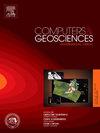Advancing Earth science applications through a semi-automatic monoplotting framework for efficient 3D geo-referencing of monocular oblique visual Data
IF 4.4
2区 地球科学
Q1 COMPUTER SCIENCE, INTERDISCIPLINARY APPLICATIONS
引用次数: 0
Abstract
The widespread availability of high-quality images from smartphones, drones, and digital cameras presents an unprecedented opportunity for global geospatial data collection. However, these images are often captured at oblique angles, making geo-referencing challenging and limiting their usability. Monoplotting, a technique that requires only a single image and a Digital Elevation Model (DEM), addresses these challenges by establishing pixel-level correspondence between imagery and real-world coordinates. However, traditional monoplotting methods are labor-intensive, requiring manual identification of control points in both the image and DEM, as well as manual tuning of camera parameters, which restricts scalability for large-scale databases and near-real-time applications. This paper proposes a novel semi-automatic monoplotting framework that minimizes human intervention. The framework integrates key point detection, geo-referenced 3D point retrieval, regularized gradient-based optimization, pose estimation, back-projection, and pixel mapping to enable efficient geo-referencing. To the best of the authors’ knowledge, this is the first study to incorporate key point detection into monoplotting, and apply regularized gradient-based optimization for camera position and parameter determination, even with unequal numbers of key points from the image and DEM. Numerical experiments with a historical image and a corresponding real-world DEM demonstrate the framework’s effectiveness. The robustness of the method is further evaluated on distorted images, where the distortion strength coefficient is treated as an unknown and estimated through projection optimization. The results confirm the framework’s ability to establish accurate correspondence between the image pixel domain and real-world 3D coordinates. Additionally, integrating machine learning models, such as semantic segmentation, highlights the framework’s advantages in Earth science applications, including snow and glacier characterization.
通过半自动单眼倾斜视觉数据的高效三维地理参考的单眼绘图框架,推进地球科学应用
来自智能手机、无人机和数码相机的高质量图像的广泛可用性为全球地理空间数据收集提供了前所未有的机会。然而,这些图像通常以倾斜角度拍摄,使得地理参考具有挑战性并限制了它们的可用性。单标绘技术,一种只需要一张图像和数字高程模型(DEM)的技术,通过在图像和现实世界的坐标之间建立像素级对应关系来解决这些挑战。然而,传统的单标绘方法是劳动密集型的,需要手动识别图像和DEM中的控制点,以及手动调整相机参数,这限制了大规模数据库和近实时应用的可扩展性。本文提出了一种新的半自动单图框架,最大限度地减少了人为干预。该框架集成了关键点检测、地理参考3D点检索、基于正则化梯度的优化、姿态估计、反向投影和像素映射,以实现高效的地理参考。据作者所知,这是第一个将关键点检测纳入单点绘图的研究,并应用基于正则化梯度的优化来确定相机位置和参数,即使图像和DEM中的关键点数量不相等。用历史图像和相应的现实世界DEM进行的数值实验证明了该框架的有效性。进一步评价了该方法在畸变图像上的鲁棒性,其中畸变强度系数作为一个未知量,通过投影优化估计。结果证实了该框架能够在图像像素域和真实世界的三维坐标之间建立精确的对应关系。此外,集成机器学习模型,如语义分割,突出了框架在地球科学应用中的优势,包括雪和冰川表征。
本文章由计算机程序翻译,如有差异,请以英文原文为准。
求助全文
约1分钟内获得全文
求助全文
来源期刊

Computers & Geosciences
地学-地球科学综合
CiteScore
9.30
自引率
6.80%
发文量
164
审稿时长
3.4 months
期刊介绍:
Computers & Geosciences publishes high impact, original research at the interface between Computer Sciences and Geosciences. Publications should apply modern computer science paradigms, whether computational or informatics-based, to address problems in the geosciences.
 求助内容:
求助内容: 应助结果提醒方式:
应助结果提醒方式:


